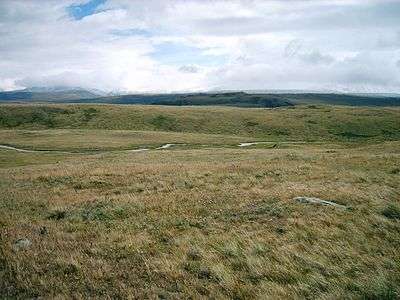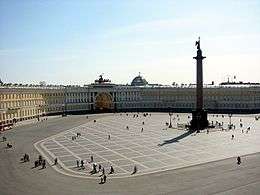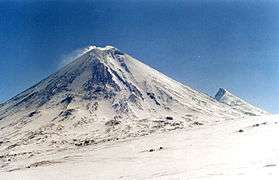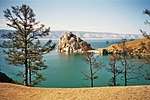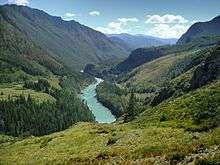Golden Mountains of Altai
Golden Mountains of Altai is the name of an UNESCO World Heritage Site consisting of the Altai and Katun Natural Reserves, Lake Teletskoye, Belukha Mountain, and the Ukok Plateau. As stated in the UNESCO description of the site, "the region represents the most complete sequence of altitudinal vegetation zones in central Siberia, from steppe, forest-steppe, mixed forest, subalpine vegetation to alpine vegetation".[1] While making its decision, UNESCO also cited Russian Altai's importance for preservation of the globally endangered mammals, such as snow leopard and the Altai argali. The site covers a vast area of 16,175 km².[2]
| UNESCO World Heritage Site | |
|---|---|
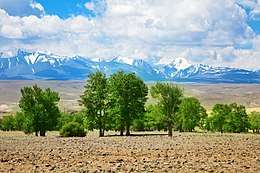 Altai Mountains | |
| Location | Altai Republic, Russia |
| Includes |
|
| Criteria | Natural: (x) |
| Reference | 768rev |
| Inscription | 1998 (22nd session) |
| Area | 1,611,457 ha (6,221.87 sq mi) |
| Coordinates | 50°28′N 86°00′E |
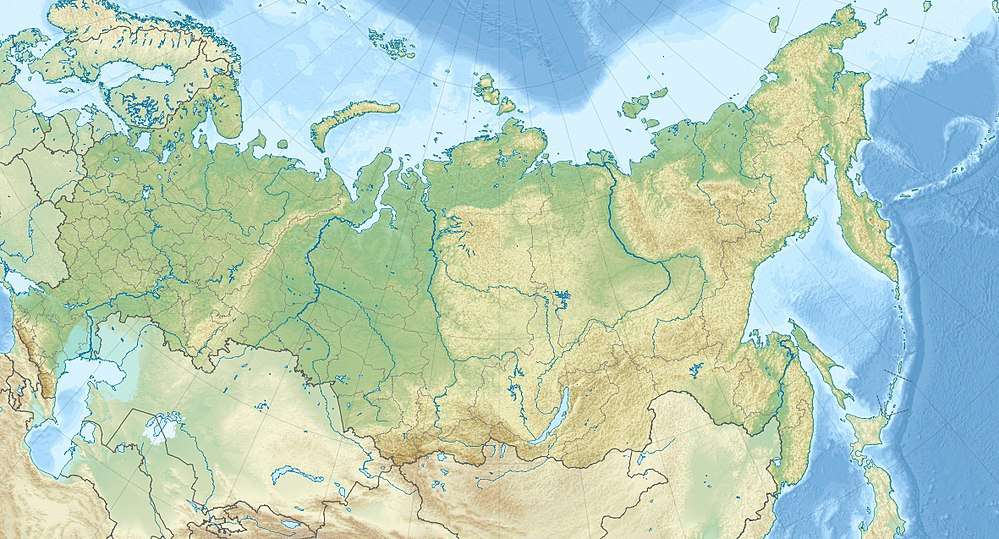 Location of Golden Mountains of Altai in Russia | |
Altai region, sites, and landscape
The Altai region is made up of four primary sites and landscapes: Mount Belukha, the Ukok Plateau, the Katun River, and the Karakol Valley. Mount Beluka is regarded as a sacred site to Buddhists and the Burkhanist. Their myths surrounding this portion of the mountain range lent credence to their claim that it was the location of Shangri-la (Shambala). This location, having first been climbed in the early 1900s, now hosts a myriad of climbers each year. The Ukok Plateau is an ancient burial site of the early Siberian people. Moreover, a number of myths are connected to this portion of the Golden Mountains. For example, the plateau was thought to have been the Elysian fields. The Katun River is an important religious location to the Altaians where they (during celebrations) utilize ancient ecological knowledge to restore and maintain the river. The Karakol Valley is home of three indigenous villages where tourism is greatly managed.[3]
Cultural value
While the Golden Mountains of Altai are listed on the World Heritage List under natural criteria, it holds information about the nomadic Scythian culture. The permafrost in these mountains has preserved Scythian burial mounds. These frozen tombs, or kurgans, hold metal objects, pieces of gold, mummified bodies, tattooed bodies, sacrificed horses, wood/leather objects, clothes, textiles, etc.[4] However, the Ukok Plateau (in the Altai Mountains) is a sacred site to the Altai people, so archeologists and scholars who are looking to excavate the site for human remains raise a great deal of controversy.[5]
British Museum exhibit controversy
The British Museum in London exhibited "Scythian Warriors of Ancient Siberia" from September 2017 to January 2018. The exhibition was sponsored by British Petroleum (BP), which was controversial.[6] At this same time the Ukok (part of the Altai Mountains) is threatened by potential building of a natural gas pipeline from Russia to China. However, the pipeline is proposed by Russian state-owned company, Gazprom, not BP.[7] Jennifer Castner, director of the Altai Project, said:
The British Museum's selection of BP as the Scythians exhibition's sponsor is disturbing for two reasons. First, BP is an international resource extraction company that seizes and destroys native lands, interrupts traditional lifeways, and demonstrates a fundamental lack of respect for the deep connection between indigenous peoples and their landscape. Secondly, there are close parallels in Altai, where BP's competitor Gazprom is seeking to build a pipeline that would destroy ancient sites, disturb documented sacred lands and monuments, and disrupt the Altaian people's semi-nomadic herding economy while simultaneously sponsoring a major renovation and exhibits at the Altai National Museum. In both instances, dominant Western cultural attitudes deny the connection between archaeology and modern native peoples, and oil-gas industry giants “launder” their own image at the expense of the Altaian people and others like them.[8]
Climate Threats
Climate change has caused the melting of the permafrost endangering the preservation of these tombs. Over the past 100 years there has been a 1°C increase in temperature across Asia and a 2°C increase in temperature in the footsteps of the Altai, with the increase more pronounced in the winter and spring.[9]
Glacial outburst floods have become a problem in this area. In particular, the Sofiyskiy Glacier in the region has been retreating at a rate of 18 meters per year.[10]
A rise in temperature also poses a threat to the various endangered species that are housed in the mountain region. These species include the snow leopard, the argali mountain sheep, the steppe eagle, and the Black Stork.[11]
Preservation Efforts
In 2005, the UNESCO World Heritage Centre launched the Preservation of the Frozen Tombs of the Altai Mountains Project with financial support from the UNESCO/Flemish Funds-in-Trust. However, as of May 14, 2008 this project has been brought to an end.[12]
Notes
- "Golden Mountains of Altai". UNESCO. Retrieved 2007-07-31.
- "Greater Altai—Altai Krai, Republic of Altai, Tyva (Tuva), and Novosibirsk—Crossroads". Archived from the original on 2007-03-14. Retrieved 2006-11-30.
- "Golden Mountains". Sacred Land Film Project.
- Colette, Augustin (2007). Case Studies on Climate Change and World Heritage. UNESCO. ISBN 978-92-3-104125-9.
- "Scythians: Climate Change and Indigenous Rights in the Altai Mountains". Culture Unsustained. WordPress.
- "Scythians: Climate Change and Indigenous Rights in the Altai Mountains". Culture Unsustained. WordPress.
- "Scythians: Climate Change and Indigenous Rights in the Altai Mountains". Culture Unsustained. WordPress.
- "Scythians: Climate Change and Indigenous Rights in the Altai Mountains". Culture Unsustained – via WordPress.
- Colette, Augustin (2007). Case Studies on Climate Change and World Heritage. UNESCO. ISBN 978-92-3-104125-9.
- Colette, Augustin (2007). Case Studies on Climate Change and World Heritage. UNESCO. ISBN 978-92-3-104125-9.
- Colette, Augustin (2007). Case Studies on Climate Change and World Heritage. UNESCO. ISBN 978-92-3-104125-9.
- Han, Junhi (14 May 2008). Publication on Frozen Tombs of the Altai Mountains. UNESCO.
External links
| Wikimedia Commons has media related to Golden Mountains of Altai World Heritage Site. |
